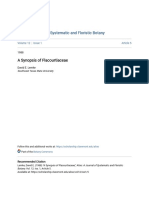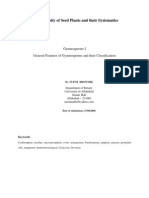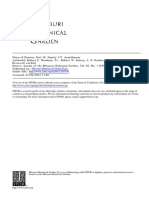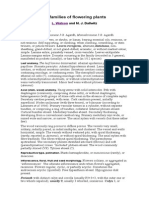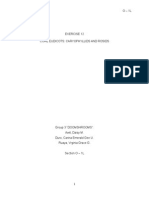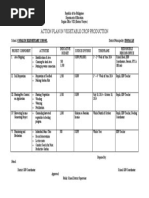The Families and Genera of Vascular Plants
The Families and Genera of Vascular Plants
Uploaded by
boutainabarhdadiCopyright:
Available Formats
The Families and Genera of Vascular Plants
The Families and Genera of Vascular Plants
Uploaded by
boutainabarhdadiCopyright
Available Formats
Share this document
Did you find this document useful?
Is this content inappropriate?
Copyright:
Available Formats
The Families and Genera of Vascular Plants
The Families and Genera of Vascular Plants
Uploaded by
boutainabarhdadiCopyright:
Available Formats
62 J.M. Arrington and K.
Kubitzki
Cistaceae
J.M. Arrington and K. Kubitzki
Cistaceae Juss., Gen. Pl.: 294 (1789), nom. cons. Vegetative Morphology and Anatomy. Cis-
taceae are predominantly shrubs or subshrubs;
Shrubs, subshrubs or herbs, often with stellate annuals are restricted to Tuberaria sect. Scorpi-
indumentum. Leaves alternate or opposite, simple, oides and Helianthemum sect. Brachypetalum
entire, often revolute, petiolate to sessile, stipulate (sensu Grosser 1903). Perennial herbs are lacking
or exstipulate; leaf venation pinnate, palmate, 1- in the family, and those appearing as such, as
nerved, or 3 more or less parallel veins. Flowers species of Lechea or Tuberaria sect. Tuberaria,
solitary or in cymose inflorescences, hermaphro- have a persistent, woody tap root and therefore are
ditic, actinomorphic, hypogynous, chasmogamous considered as halfshrubs (Troll 1969). Stipules are
or cleistogamous; sepals 3 or (4)5, when 5, the outer reported to occur erratically in the family but it
2 often bract-like and narrower or shorter, or needs to be explored whether or not these struc-
connate to the inner 3 prominent sepals, convolute, tures correspond to prophylls or other leaves
often persistent; petals yellow, white or reddish developed on precocious axillary shoots.
(maroon, pink, purplish, orange), free, (3)5 or 0 The combination of diverse hair types on the
(cleistogamous flowers), convolute in bud in the calyx, stem, and leaf is a characteristic of the
opposite direction to that of the sepals, ephemeral family. Hairs are glandular (multicellular and cap-
or rarely marcescent; stamens numerous, or 3–10 itate or elongate-uniseriate, rarely peltate scales)
(cleistogamous flowers, some annuals, Lechea), or nonglandular (simple, tufted, stellate). Stellate
filaments distinct, sometimes sensitive; anthers hairs are actually clustered, “falsely bicellular”
basifixed, introrse, tetrasporangiate, 2-locular at unicellular trichomes (similar hairs occur only in
anthesis, longitudinally dehiscent (sometimes Combretaceae). The illusion of basal bicellularity
apically in cleistogamous flowers); gynoecium is due to a conical or concave cellulose membrane
(2)3–5(6–12)-carpellate; ovary 1- or imperfectly within the cell wall (Grosser 1903; Metcalfe and
(2)3–5(6–12)-locular due to intruded parietal Chalk 1950). The assemblage of this hair type is a
placentae; placentae filiform (shield-like); ovules distinctive trait of the Cistaceae.
2–many on each placenta, orthotropous (ana- The leaves of the Cistaceae often possess cys-
tropous, hemianatropous), bitegmic and crassinu- toliths. Stomates are anomocytic, present on one
cellar; funicles well-developed; style simple, long or both leaf surfaces, and without subsidiary cells.
to very short or wanting; stigma large and capitate In the minor leaf veins, phloem transfer cells
or discoid, often lobed, seldom minute, or rarely are present (e.g., Helianthemum) or absent (e.g.,
stigmas 3 and fimbriate-plumose. Capsule loculici- Cistus).
dal (septifragous), (2)3–5(6–12)-valved, upright Nodes have been reported to be unilacunar.
or pendent, few- to many-seeded; often enveloped However, a comprehensive survey of the taxa and
by persistent sepals. Seeds very small; seed coat of trace-type appears to be lacking. The xylem of the
2 integuments, the outer thin, sometimes gelati- Cistaceae consists of both vessels with simple end
nous when moist, the inner very hard; endosperm walls and tracheids. Fibre tracheids are present;
starchy, nuclear, thin-walled; embryo curved, bent vestured pits have been observed in the secondary
into a hook or ring, more or less circinately coiled, xylem of Cistus (Baas and Werker 1981). Wood
plicate or biplicate,rarely almost straight,central or rays are low and heterocellular, mostly uniseriate.
more or less peripheral; cotyledons narrow to ellip- Wood parenchyma is wanting or very scanty. Sec-
tical-orbicular,straight to strongly bent. ondary thickening of the stem develops from a
The family comprises 8 genera and about 180 typical cambial ring. Sieve elements of the phloem
species mostly in temperate and subtropical are of the Ss-type (Behnke 1991); internal phloem
regions of the northern hemisphere, especially the is absent. Stems in cross section are cylindrical
western Mediterranean region, with a secondary or tetragonal. Root hairs are lacking; see under
center in the eastern United States. Distribution and Habitats below.
K. Kubitzki et al. (eds.), Flowering Plants · Dicotyledons
© Springer-Verlag Berlin Heidelberg 2003
Cistaceae 63
Inflorescence and Floral Structure. Cleistogamous flowers regularly occur in certain
Flowers are solitary or grouped in unilateral, scor- species of Helianthemum, Tuberaria and Crocan-
pioid, or more or less symmetrical cymose inflo- themum, and rarely (M. Sanchez and J. Güemes,
rescences. Flowers usually open only in full pers. comm.; Grosser 1903) in Fumana. Cleis-
sunlight for a few hours, and the petals are typi- togamy tends to develop subsequent to chas-
cally ephemeral. Most flowers have five conspicu- mogamy in late summer and autumn. However,
ous petals, exceptions include cleistogamous chasmogamous and cleistogamous flowers regu-
flowers and Lechea (three minute petals). The larly co-occur in Helianthemum sect. Eriocarpum
petals have a multipapillate epidermis with about (arid regions of the Old World) and Crocanthe-
10 micro-papillae per cell which project from an mum sect. Lecheoides (New World). In cleistoga-
elongate epidermal cell (Barthlott 1981). Petals mous flowers, the petals (sometimes absent) and
with such an epidermis are rare among sepals are smaller, the stamens are usually reduced
angiosperms (Kay et al. 1981), and the cistaceous in number and size, and the capsules are often
type is a potential apomorphy for the family. smaller and contain fewer seeds. The anthers of
Stigmas are dry and possess a papillate surface. cleistogamous flowers in Crocanthemum sect.
The multicellular and multiseriate papillae are Lecheoides and Helianthemum sect. Eriocarpum
exclusive to the Cistaceae among other malvalean are usually fused to the stigma and apically
families (Nandi 1998a), and are a rare feature dehisce at the point of adherence (Grosser 1903;
among the angiosperms (Heslop-Harrison and Daoud and Wilbur 1965). The occurrence of cleis-
Shivanna 1977). togamy, reported in Halimium (Lord 1981) and
Floral ontogeny has been studied by several Lechea (Darwin 1877), should be further investi-
authors, most recently by Nandi (1998b). The gated, especially in the flowers of Lechea which
irregular calyx (unequal and/or variable in sepal rarely fully expand.
number) is a distinguishing characteristic for the
family. The basic sepal number is five. Sepals arise Embryology. Anthers are tetrasporangiate; the
sequentially; in some species the inner three tapetum is glandular. Microsporogenesis is simul-
develop from a ring primordium. Early in devel- taneous, and the initial microspore tetrads are
opment five sepal primordia appear but later on in tetrahedral, isobilateral or decussate. Ovules are
some species sepals 1 and 4, and/or sepals 2 and 5 bitegmic, crassinucellar, and orthotropous, except
become partially or wholly fused (Saunders 1936). for Fumana where the ovules are anatropous to
The androecium develops centrifugally and hemianatropous. The micropyle is formed by both
usually from a ring wall primordium (in taxa with integuments, mostly the outer (Nandi 1999b). The
a higher number of stamens). The first stamens to embryo sac formation follows the Polygonum
be formed on the ring wall tend to appear in type. The endosperm is nuclear (Kapil and
alternipetalous position (Saunders 1936; Nandi Maheswari 1964; Davis 1966).
1998b). Further stamen primordia appear in the
gaps between the previously formed primordia. In Pollen Morphology. (Heydacker 1963;
the genera examined by Nandi (1998b), Lechea is Ukraintseva 1993; J.M. Arrington, pers. obs.).
exceptional in producing single and compound Pollen grains are spheroid, oblate or prolate and
stamen primordia. The epidermis of cistaceous tricolpor(oid)ate monads; two Crocanthemum
anthers is persistent and the endothecium devel- spp. are reported as having loose tetrads (Tomb
ops fibrous thickenings. 1999; J.W. Horn, pers. comm.). Exine sculpture is
In Cistus, the gynoecium is 5(6–12)-carpellate, reticulate, rugulose, striate, or striate-reticulate.
but in all other Cistaceae it is 3-carpellate. Placen- Pollen morphology is largely in accord with
tation is parietal, but the placentae can be deeply generic, subgeneric and sectional classification.
intruded (e.g., Cistus) and then appear axile. The Six major pollen types can be recognized: (1)
shape is generally filiform with the exception of the Fumana type is tricolpor(oid)ate, oblate-
Lechea in which the placentae are shield-like. spheroidal to spheroidal with short, broad colpi
Funicles are well-developed and vary from filiform and large, unequal lumina; (2) the Lechea type is
(e.g., Cistus, Halimium, Crocanthemum, Hudsonia, tricolporate, oblate-spheroidal to slightly prolate-
a few Helianthemum) to robust (Lechea) and spheroidal with irregular long colpi and a distinc-
swollen in the center (e.g., Tuberaria) or towards tive infra-reticulate texture; (3) the Helianthemum
the end (e.g., most Helianthemum). They are type is tricolporate, prolate-spheroidal to prolate
ascending, somewhat straight or resupinate, and with long colpi; subtypes correspond to sub-
elongate or short. generic taxonomy; (4) the Cistus type is tricol-
You might also like
- Aquatic Ecology and ResourcesDocument28 pagesAquatic Ecology and ResourcesErine ContranoNo ratings yet
- 3 Meerow 1998Document2 pages3 Meerow 1998Emma ValentinaNo ratings yet
- Campanulaceae: Campanula Medium) or Long-Lived (E.g. Lobelia Wollastonii)Document31 pagesCampanulaceae: Campanula Medium) or Long-Lived (E.g. Lobelia Wollastonii)María Mónica Henao-CárdenasNo ratings yet
- Bayer 2003Document87 pagesBayer 2003Juan David Rodriguez HurtadoNo ratings yet
- AssignmentDocument11 pagesAssignmentAhmad ShahidNo ratings yet
- Pteridophytes MorphologyDocument79 pagesPteridophytes MorphologyBoopathiAyyanarM100% (1)
- ADIANTUMDocument6 pagesADIANTUMsilveesharma1No ratings yet
- Convolvulaceae NotasDocument43 pagesConvolvulaceae Notascesar3126No ratings yet
- Flora of China Vol 23 Cyperaceae PDFDocument298 pagesFlora of China Vol 23 Cyperaceae PDFHabibNo ratings yet
- K 4-6 (-14) C 8 - (0) A G (3 - ), Superior or InferiorDocument6 pagesK 4-6 (-14) C 8 - (0) A G (3 - ), Superior or InferiorAlbert CorderoNo ratings yet
- Regalado 1995. Revision of Philippine Medinilla (Melastomataceae)Document41 pagesRegalado 1995. Revision of Philippine Medinilla (Melastomataceae)earl.mendes2No ratings yet
- Flora Australia 03 Hamamelidales Casuarinales PDFDocument247 pagesFlora Australia 03 Hamamelidales Casuarinales PDF_meianti100% (1)
- Hymenophylum HymenophyllalesDocument8 pagesHymenophylum HymenophyllalesCDB 1st Semester 2077No ratings yet
- Bonnetiaceae: Roraimae. Archytaea and Ploiarium Have VascuDocument4 pagesBonnetiaceae: Roraimae. Archytaea and Ploiarium Have VascuLevvis AicragNo ratings yet
- A Synopsis of FlacourtiaceaeDocument16 pagesA Synopsis of FlacourtiaceaeJuan David Rodriguez HurtadoNo ratings yet
- Anderson2002Curculionidae PDFDocument94 pagesAnderson2002Curculionidae PDFjose gpeNo ratings yet
- MonachosoraceaeDocument4 pagesMonachosoraceaesolo baru075No ratings yet
- El Pueblo Soy YoDocument5 pagesEl Pueblo Soy YoNilson Esmar TorresNo ratings yet
- FISSIDENTACEAE Schimper: Ronald A. PursellDocument13 pagesFISSIDENTACEAE Schimper: Ronald A. PursellCristopher Jimenez OrozcoNo ratings yet
- 7 BryopsidaDocument10 pages7 Bryopsidanabin sharmaNo ratings yet
- Acanthaceae - Justicia - Wasshausen Brittonia 54 2002Document13 pagesAcanthaceae - Justicia - Wasshausen Brittonia 54 2002Simone MeijonNo ratings yet
- OleandraceaeDocument14 pagesOleandraceaesolo baru075No ratings yet
- Livro MetcalfeDocument60 pagesLivro MetcalfeAndressa FernandaNo ratings yet
- Lec # 17-18 (3)Document20 pagesLec # 17-18 (3)emanshahbaz003No ratings yet
- 05 LabiataeDocument4 pages05 Labiataealaa elkadyNo ratings yet
- PterisDocument4 pagesPterisSreeja RajNo ratings yet
- Adaptive and Protective SystemsDocument40 pagesAdaptive and Protective Systemsrutwick90% (10)
- Menispermaceae - WikipediaDocument11 pagesMenispermaceae - Wikipediajle_dl100% (1)
- I. Polypodiopsida (Licopsida) : A. Order: OsmundalesDocument26 pagesI. Polypodiopsida (Licopsida) : A. Order: OsmundalesCDB 1st Semester 2077No ratings yet
- Where can buy (eBook PDF) Equity & Trusts: Text, Cases, & Materials (Text, Cases, and Materials) 3rd Edition ebook with cheap priceDocument25 pagesWhere can buy (eBook PDF) Equity & Trusts: Text, Cases, & Materials (Text, Cases, and Materials) 3rd Edition ebook with cheap pricenajkalentii100% (2)
- BNHM Botany SeriesDocument84 pagesBNHM Botany SeriesaaguilardNo ratings yet
- Austin, D. F. The Genus Aniseia (Convolvulaceae)Document11 pagesAustin, D. F. The Genus Aniseia (Convolvulaceae)Biblioteca ImbivNo ratings yet
- EtymologyDocument11 pagesEtymologyJonee SansomNo ratings yet
- CucurbitaceaeDocument10 pagesCucurbitaceaeladimeji07No ratings yet
- Solanaceae: Distribution-And-Types/48409Document5 pagesSolanaceae: Distribution-And-Types/48409Fitrie Sii BismaniacNo ratings yet
- Occurrence and Distribution of Osmunda:: Morphology of The PlantDocument12 pagesOccurrence and Distribution of Osmunda:: Morphology of The PlantCDB 1st Semester 2077No ratings yet
- acanthaceaeDocument17 pagesacanthaceaeomrajegorde862No ratings yet
- Diversity of Seed Plants and Their Systematics by DR Nupur BhowmickDocument26 pagesDiversity of Seed Plants and Their Systematics by DR Nupur Bhowmickdapolra55100% (2)
- SELAGINELLADocument30 pagesSELAGINELLAJán ŠormanNo ratings yet
- ACANTHACEAE - Flora Panama PDFDocument130 pagesACANTHACEAE - Flora Panama PDFJose GuerreroNo ratings yet
- Unique Type of Angiosperm Pollen From The Family Annonaceae: James W. WalkerDocument4 pagesUnique Type of Angiosperm Pollen From The Family Annonaceae: James W. Walkermagicman20202000No ratings yet
- Clave para Los Antoceros de Colombia PDFDocument9 pagesClave para Los Antoceros de Colombia PDFYennifer RamosNo ratings yet
- LYGINOPTERIS OLDHAMIA B.Sc. Part II Botany Hons. Prof. (DR.) Manorma Kumari, Botany, ANCDocument6 pagesLYGINOPTERIS OLDHAMIA B.Sc. Part II Botany Hons. Prof. (DR.) Manorma Kumari, Botany, ANCJannatul Mala100% (1)
- CAMELLIA LinnaeusDocument47 pagesCAMELLIA LinnaeusndcrbzsprsNo ratings yet
- Pteridophyte SpeciesDocument73 pagesPteridophyte SpeciesAnjaliNo ratings yet
- Classification, Economic Ecological Importance of BryophytaDocument14 pagesClassification, Economic Ecological Importance of BryophytaShaik Muhammad Sayeed100% (1)
- Review NotesDocument4 pagesReview NoteshonnyremotoNo ratings yet
- Life Cycle of CycasDocument33 pagesLife Cycle of CycasIkshya kcNo ratings yet
- Wa0001.Document53 pagesWa0001.www.arfiya456No ratings yet
- Bluejay 413 Art 130Document9 pagesBluejay 413 Art 130Bailey AnneNo ratings yet
- #Anthoceros - Botany OptionalDocument15 pages#Anthoceros - Botany OptionalElavarasi MurugesanNo ratings yet
- The Families of Flowering PlantsDocument3 pagesThe Families of Flowering PlantsDann VergaraNo ratings yet
- Cajaninae of Australia (Leguminosae: Papilionoideae) : L. J. G. Van Der MaesenDocument9 pagesCajaninae of Australia (Leguminosae: Papilionoideae) : L. J. G. Van Der MaesenSheilla Moreno PérezNo ratings yet
- Clasificacion Taxonomica de Curculionidae Anderson2002Document94 pagesClasificacion Taxonomica de Curculionidae Anderson2002jose gpe100% (1)
- Plant HistologyDocument2 pagesPlant HistologyNurul Rayhana100% (3)
- Vol.24 - Parte 7.3Document152 pagesVol.24 - Parte 7.3Majo TorallaNo ratings yet
- Green 2002Document51 pagesGreen 2002ΑΝΑΣΤΑΣΙΑ ΝΕΡΑΝΤΖΗNo ratings yet
- Araceae Families and Genera of PlantsDocument49 pagesAraceae Families and Genera of PlantsJhon W. MuñuicoNo ratings yet
- Group 3 O - 1L 1Bsb - CDocument9 pagesGroup 3 O - 1L 1Bsb - CVGRuayaNo ratings yet
- s41598-020-80003-yDocument12 pagess41598-020-80003-yboutainabarhdadiNo ratings yet
- plants-11-00588-v2Document18 pagesplants-11-00588-v2boutainabarhdadiNo ratings yet
- FileDocument13 pagesFileboutainabarhdadiNo ratings yet
- BRIAC143.053Document18 pagesBRIAC143.053boutainabarhdadiNo ratings yet
- BioMed Research International - 2017 - Sayah - Antioxidant Activity and Inhibitory Potential of Cistus Salviifolius LDocument7 pagesBioMed Research International - 2017 - Sayah - Antioxidant Activity and Inhibitory Potential of Cistus Salviifolius LboutainabarhdadiNo ratings yet
- General Biology 2 (Reproduction - Sexual Reproduction in Plants)Document12 pagesGeneral Biology 2 (Reproduction - Sexual Reproduction in Plants)Jean DaclesNo ratings yet
- Kitchen Window Herb GardenDocument2 pagesKitchen Window Herb GardenNevin SmithNo ratings yet
- Work Sheets: Chap: Arithmetic Progressions & Co-Ordinate Geometry Grade: 10Document15 pagesWork Sheets: Chap: Arithmetic Progressions & Co-Ordinate Geometry Grade: 10Darshan GopalakrishnanNo ratings yet
- Reading Comprehension 10Document2 pagesReading Comprehension 10Maria VoznaNo ratings yet
- DLP English-2Document7 pagesDLP English-2burtanognoimeNo ratings yet
- SantolDocument4 pagesSantolBTS ARMYNo ratings yet
- Bakers Price ListDocument2 pagesBakers Price ListRose DuffyNo ratings yet
- Marist Secondary School-1Document18 pagesMarist Secondary School-1youngmiboss78No ratings yet
- BrocherDocument17 pagesBrocherambaprasad.hdfcNo ratings yet
- DLTP Booklet Sukuma Wiki FINAL TWXMUyJDocument5 pagesDLTP Booklet Sukuma Wiki FINAL TWXMUyJchessavidNo ratings yet
- Prohexadione OliveDocument3 pagesProhexadione Olivetcamel8No ratings yet
- Reference:: Weeds of Rice in Asia by Carton, B.P., Mortimer, M., Hill, J.E., and Johnson, D.E Weeds of Bhutan by Chris ParkerDocument2 pagesReference:: Weeds of Rice in Asia by Carton, B.P., Mortimer, M., Hill, J.E., and Johnson, D.E Weeds of Bhutan by Chris ParkeraiktiplarNo ratings yet
- V Part 1Document15 pagesV Part 1Mans LaderaNo ratings yet
- PlantresearchvaldovinosDocument2 pagesPlantresearchvaldovinosapi-293796279No ratings yet
- ICAR AIEEA (P.G.) Agronomy 2020 Previous Year PaperDocument59 pagesICAR AIEEA (P.G.) Agronomy 2020 Previous Year Papersafavam165No ratings yet
- Biology Ppqs End Year Exam Year 10 PDFDocument81 pagesBiology Ppqs End Year Exam Year 10 PDFfatimatumbiNo ratings yet
- Tle9 - q1 - Mod1 - Types of Equipment Tools and Materials - v3Document21 pagesTle9 - q1 - Mod1 - Types of Equipment Tools and Materials - v3Jennifer CarrascalNo ratings yet
- Advantages and Applications of Coir Fiber.20140216.020127Document1 pageAdvantages and Applications of Coir Fiber.20140216.020127hubcapcook4No ratings yet
- Assignment 2018Document8 pagesAssignment 2018Shafin AhmedNo ratings yet
- GymnospermsDocument11 pagesGymnospermsapi-261447125No ratings yet
- 2023 La Crete ProgramDocument12 pages2023 La Crete ProgramOrganicAlbertaNo ratings yet
- Australian House & Garden - June 2020 AU PDFDocument180 pagesAustralian House & Garden - June 2020 AU PDFpeter100% (1)
- DTAM - Chap02 - Review of Ag MachineryDocument31 pagesDTAM - Chap02 - Review of Ag MachineryJohn CennaNo ratings yet
- Action Plan Gulayan Sa PaaralanDocument1 pageAction Plan Gulayan Sa PaaralanGiancarlo BarandinoNo ratings yet
- Rahuri FruitsDocument10 pagesRahuri FruitskrsnacryptoartNo ratings yet
- Tled 205 - Agri-Fishery Arts Part I-Introduction To Agriculture and Fishery ArtsDocument35 pagesTled 205 - Agri-Fishery Arts Part I-Introduction To Agriculture and Fishery Artscharmen rogandoNo ratings yet
- Your Certified Exceptional Apartment GuideDocument5 pagesYour Certified Exceptional Apartment GuideconquistandolesNo ratings yet
- to Study a Plant of Family SolanaceaeDocument3 pagesto Study a Plant of Family Solanaceaeanushkapatel4720No ratings yet
- Tomato PlantDocument2 pagesTomato PlantBerenguel, Mark DarwinNo ratings yet















